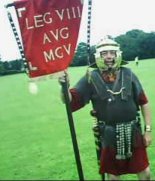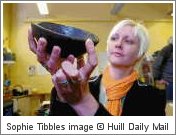Download the reports | Print this page
Summary page 2 page 1 | page 3 | Back to LHG Main Page
Some of the residents of the village who joined us on that night also brought along items that they had found in their gardens adding a little to the history of the village. The second evening was for logging the finds we had washed on the previous event. This required team work and the villagers divided into groups to measure, identify (pottery, metal, coin) and approximately date (Romano British, modern) the items which tested the brain power in many instances.
 The next phase saw us choosing Archaeological Project Services (APS) to do the professional archaeological work for us and on 9th September 2006 on a cold windy day, the geophysical examination was carried out over several days. The results showed a very busy print out indicating a very exciting site. Interpretation of all the dots and lines indicated archaeological features, such as possible ditches, earthworks and banks.
The next phase saw us choosing Archaeological Project Services (APS) to do the professional archaeological work for us and on 9th September 2006 on a cold windy day, the geophysical examination was carried out over several days. The results showed a very busy print out indicating a very exciting site. Interpretation of all the dots and lines indicated archaeological features, such as possible ditches, earthworks and banks.
It was felt there was evidence of roundhouses surrounded by a bank and ditch system in one area. Magnetic disturbances also suggested industrial activity had taken place. The regularity of the arrangement of ditches, together with the discovery of a lot of roman pottery confirmed Roman occupation in another area of the site. So it appeared we had two separate settlement areas and possibly a period of co-habitation of the site as a whole, as quite commonly, new occupiers would often build over previous settlements.
|
|
September 2007 at last saw the commencement of the dig. We had previously held several meetings with APS to decide where to put the test trenches and our plan was to open 4 trenches, but if a trench proved to be barren, it would be quickly closed in the hope there would be time to open another. Over 5 very warm sunny days, 6 trenches were opened, four on the Roman site and two on the Iron Age site. The archaeologists were assisted by volunteers and metal detectorists. All the soil excavated was checked over by the metal detectorists who also covered the surrounding area making many metal finds, predominantly late Roman coins. There was evidence in the trenches of lines of ditches and in one, a pit. The trenches were "cleaned off" and areas excavated further by hand to look for dating evidence (mainly in the form of pottery). Environmental samples and photographs were taken and scale drawings made of the trenches. We were able to excavate most of the trenches in some detail. One of the main difficulties we encountered was the high water table which resulted in the flooding of parts of trenches. Nevertheless we made a number of particularly interesting discoveries: evidence of burning, padstones for posts from a building, a large storage jar, broken but more complete than anything found before. Our most unexpected find later, was small pieces of Roman plaster on which there appears to be painted purple grapes. This area was not investigated further. The conclusion is as follows, taken directly from the archaeologists report, compiled by APS: page 2 of 3« Previous page | Conclusion » |
© Wrawby Local History Society 2008-2009
 A Roman Roadshow was held in April, 2007, in the Village Hall, primarily to announce the findings of the geophysical survey to the village but also to explain all our activities from the start of the project showing details of each process. An exhibition of the items we had found during field walking was on display supported by a magnificent collection of Roman pottery brought along by Maggi Darling, an expert on Roman pottery who joined us for the day to answer questions asked by members of
A Roman Roadshow was held in April, 2007, in the Village Hall, primarily to announce the findings of the geophysical survey to the village but also to explain all our activities from the start of the project showing details of each process. An exhibition of the items we had found during field walking was on display supported by a magnificent collection of Roman pottery brought along by Maggi Darling, an expert on Roman pottery who joined us for the day to answer questions asked by members of the public. Similarly, John and Sophie Tibbles, experts on Roman brick and tile also supported us with their knowledge giving an amazing insight into the variety of their subject. Steve Malone from A.P.S. was kept busy explaining to interested people exactly what the geophysical print out indicated and Ian Rowlandson, Community Archaeologist from Scunthorpe Museum, was on hand to identify finds that local people bought in with them. The children on the day were well catered for with a small workshop, a giant mosaic to make and fun with a metal detector, several children taking home roman coins they had "found". We were delighted that nearly 200 people joined us on the day indicating the level of interest in our project.
the public. Similarly, John and Sophie Tibbles, experts on Roman brick and tile also supported us with their knowledge giving an amazing insight into the variety of their subject. Steve Malone from A.P.S. was kept busy explaining to interested people exactly what the geophysical print out indicated and Ian Rowlandson, Community Archaeologist from Scunthorpe Museum, was on hand to identify finds that local people bought in with them. The children on the day were well catered for with a small workshop, a giant mosaic to make and fun with a metal detector, several children taking home roman coins they had "found". We were delighted that nearly 200 people joined us on the day indicating the level of interest in our project.